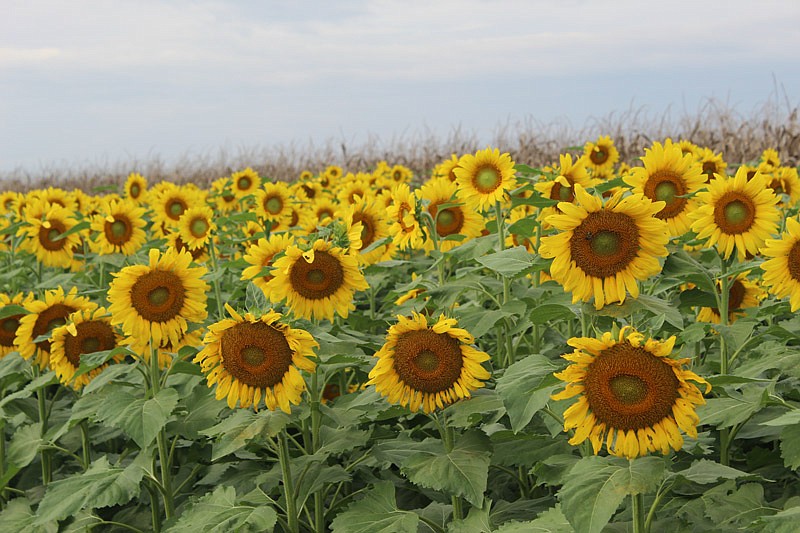Jay Fischer's sunflowers look great, but they weren't his first crop this year.
Instead, the local farmer's sunflowers are on the same 45-acre plot from which he harvested oats just a couple months ago.
"Sunflowers are actually a short-enough crop," he said.
The eye-catching tall, yellow flowers require only an 80-to-90-day growing window, he said. In comparison, corn, a crop with much higher Show-Me-State acreage, might take up to five months from planting to harvest.
Fischer Farms is located just north of Jefferson City in the Missouri River valley. The farmer - who also operates a corn maze and pumpkin patch - anticipates a high-quality crop. Harvest time is in late November.
"The August rain was really good for them - they came up and got going," he said.
Fischer's sunflowers will become birdseed; he contracts with a local feed store.
And with no major sunflower oil purchaser nearby, that's probably the best route.
"Even though sunflowers have a sizable national market, there are very few options for selling them wholesale in Missouri," said Rob Myers, regional director of extension programs for North Central Region Sustainable Agriculture Research and Education and a University Missouri associate professor of plant sciences. "Usually, the farmers that do grow sunflowers in Missouri either line up a contract before harvest with a birdseed packager or arrange to package their own sunflowers for birdseed sales."
As for Show-Me-State farmers such as Fischer who can find a market, raising a crop is usually no trouble.
"Sunflowers are well-adapted to Missouri, being native to this region," Myers said. "They grow quite well on a wide range of soils in Missouri and work well in a rotation with corn, soybeans and wheat."
While Fischer's method of double-cropping sunflowers on the same acreage as his grain is common, other farmers plant them in early spring, Myers said.
"From an agronomic standpoint, I do think they are a good option to help diversify a farmer's crop rotation in Missouri," he said. "However, the lack of very many marketing options in Missouri makes me advise farmers to have a good marketing plan before growing sunflowers as a crop. We are more limited by lack of sunflower markets than we are by soil type or other growing conditions."
Sunflower acreage grew throughout the Midwest - including Missouri - during the 1970s, Myers said. Acreage peaked in the early 2000s at about 10,000 acres statewide, he recalled, but declined when corn and soybean prices increased.
Now, Myers estimates the Show-Me State holds just a few thousand sunflower acres.
In comparison, North Dakota will harvest 418,000 sunflower acres this season and South Dakota 604,000, according to a U.S. Department of Agriculture report released Oct. 12. That means this year the Dakotas are producing roughly 75 percent of the country's 1.35 million-acre sunflower crop.
Why? First, their drought tolerance and quick growth make sunflowers a popular choice for farmers in that cold, dry region. Second, marketing options are more plentiful.
"Sunflowers are particularly popular in North Dakota both because of their short growing season and the lower rainfall in North Dakota, plus the fact that there are a substantial amount of sunflower buyers and processors in that state," Myers said.
The USDA report lists sunflower acreage for a half-dozen other states, not including Missouri.
Nationwide, John Sandbakken predicts a sunflower harvest heavier on quality than quantity. The National Sunflower Association executive director pointed out a drought in North and South Dakota hurt yields.
"It looks like it's going to be a smaller harvest," he said in a phone interview.
Sandbakken anticipates production well below last year's record-breaking crop and somewhat under the long-term average.
The sunflower harvest for 2016 yielded about 1.53 million acres with an average of 1,731 pounds per acre, according to the USDA report.
This year's projected 1.35-million-acre harvest also contains fewer pounds per acre, at 1,339. However, there is good news.
"Overall, the quality is very good," Sandbakken said. "What is harvested will be a very good-quality crop."
While Missouri farmers such as Fischer are more likely to market their sunflowers for birdseed, its No. 1 use is oil. Sunflower oil has grown in popularity since about 1996, Sandbakken said. Much of the oil the plant produces is high in oleic acid and free of unhealthy trans fat.
As demand went up, so did acreage.
"Companies wanted to get away from having trans fat in their oil, and sunflower oil is naturally stable," Sandbakken said. "We don't have trans fat in our oil. What it's done is it's given more opportunity for sunflower."

